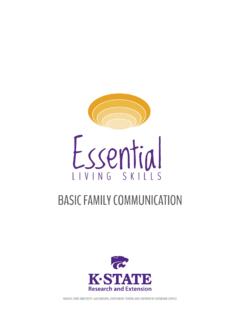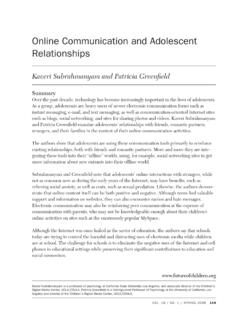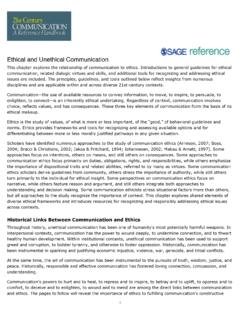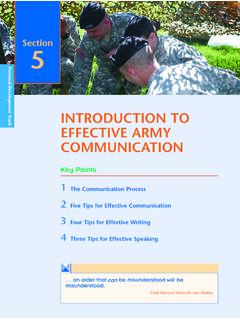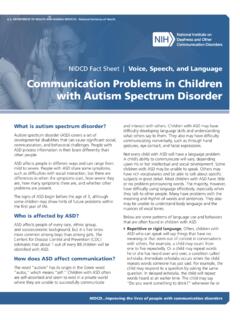Transcription of Teaching Communication Skills to Children with Autism …
1 ContentsNote: page numbers on actual pages correspond to those in the book. The table of contents merely describes page numbers as they appear on the 2-3 Assessment Text 4-7 Suggested Tools 8-9 Getting Results 10-11 Language Development 12-16 Reinforcer Assessment 17-18 Communication Incentives 19-21 Reinforcement Forms 22-34 AAC Assessment/Vocabulary 35-36 Symbol Use 37-40 Home/School Communication 41-42 Cue Hierarchy Grid 43 Object Symbols/Plans 44-45 Teaching Gestures, Expressions and Body Language 46-51 Recognizing Sarcasm 52-54 Voice Pitch 55-57 Sample Social Story 58 Common Responses 59-62 Asking for Help 63-67 Personal Space 68-69 Balanced Conversations 70-71 Teaching Communication Skills to Children with AutismI n t ro d u c t i o nCommunication is an essential part of everyday life. Communication encompasses so much that defining it can be difficult, but the heart of Communication is the exchange of messages, thoughts, feelings, and information from one person to another.
2 It s a process we observe hundreds of times throughout the day, but it is far more complex than it seems. For an exchange to occur, someone has to express an idea (expressive Communication ) and at least one person has to receive and understand it (receptive Communication ). While these processes function together to create a Communication exchange, and are interrelated, each requires its own set of subskills and needs to be looked at separately. A student may understand what is said to him but be unable to formulate a response. On the other hand, someone may be able to express her own thoughts but lack the perspective to understand what is said to her. We tend to think of Communication happening primarily through speech and written language, but we also use gestures, facial expressions, body postures, tone of voice, and behavior to convey messages. Understanding and using nonverbal, as well as verbal, Communication is a necessary part of effective information exchange.
3 A timely gesture or facial expression may more clearly express what a person is thinking than the spoken the combination of verbal and nonverbal language is the way most individuals communicate, other methods can be used to enhance or substitute for spoken language. Sign language is, of course, the most common. Objects, pictures, or written words can also be used in a variety of ways to convey messages. Since individuals on the Autism spectrum vary greatly in their Communication , and what works for one may not work with the next, we need to have a wide array of tools as we work with each child to build a bridge to effective Communication . This book will provide an overview of commonly used methods and strategies for addressing the Communication needs of individuals on the spectrum, from the nonverbal and beginning communicator to the highly verbal individual with high functioning Autism or Asperger Syndrome. Introduction How Does Autism affect Communication ?
4 On its website, the Autism Society of America defines Autism as the following: Autism is a complex developmental disability that typically appears during the first three years of life and affects a person s ability to communicate and interact with others. Autism is defined by a certain set of behaviors and is a spectrum disorder that affects individuals differently and to varying degrees. ( ) Autism Spectrum Disorders (ASD) differ greatly from one person to the next, but by definition, ASD impacts the ability to communicate and interact with others. How Communication is affected also differs greatly. People on one end of the spectrum have no means of Communication and may appear totally disinterested in those around them, seeming to exist in a world of their own. On the other end are those described as having high functioning Autism (HFA) or Asperger Syndrome. Their language Skills are usually on par for their age, and they may seek out others and talk incessantly, but they lack conversation Skills and appear awkward in their attempts to socialize.
5 It s often hard to determine where each person fits on the Communication continuum. However, to provide some organization, I have divided methods and strategies into two sections: needs of nonverbal and beginning communicators are addressed in part one, and part two focuses on verbal communicators. These are not clear divisions. Strategies in part one may be useful for Children described in part two and vice versa. Part one looks at the characteristics, assessment, and most common interventions for Children who do not speak at all or those who use only a few words. It also covers the use of Augmentative and Alternative Communication (AAC).Part two addresses the Communication needs of the verbal child. Packaged programs are not commonly used at this level since there is such a range of Skills and ability levels that it would be impossible for any single program to attempt to meet the many needs. In part two, strategies and activities are described that address different Communication needs, including repetitive language, difficulties in understanding verbal and nonverbal Communication , language usage, and conversation Skills .
6 It is impossible to draw a line between Communication Part One Chapter 1 11 Challenges in Assessing CommunicationIn order to provide the best, most targeted Communication treatment program for a child with Autism , a comprehensive Communication evaluation needs to be conducted by a speech-language pathologist (SLP). This assessment needs to evaluate pragmatic language Skills (functional and social Communication ) as well as semantic language Skills (the meaning of language including content and context). Because of the unique nature of Autism , the assessment requires a team effort, involving family, teachers, and others who know the child well, and it should include more than standardized testing. A complete picture of the child is needed to make treatment decisions and to provide a baseline by which progress can be measured. Professionals face a number of challenges when trying to accurately assess Communication abilities of a child with Autism . The following factors need to be considered when planning the child may have difficulties understanding directions or how to respond.
7 He may lack the Communication Skills to answer yes or no. A child with Autism may lack motivation because she does not understand the importance of trying to do her best in a testing child with Autism may suffer from anxiety and will not function well in an unfamiliar situation with an unfamiliar adult. Distractibility and disorganization are often associated with Autism and can make performing on cue child s ability to respond and communicate can vary a great deal from one day to the next, making it difficult to get an accurate measure. There can also be significant discrepancies from one skill to the next. A child with high functioning Autism may appear to have a well-developed expressive vocabulary, while his receptive language Skills are testing situation is different from everyday life. How the child interacts in the classroom or at home may not be reflected in the assessment setting, where interactions take place in a one-on-one, organized format. The following assessments in chapter 1 can be used with all students addressed in part one and part Teaching Communication Skills to Children with AutismDuring an assessment, the child is given more time to process language than during typical everyday exchanges.
8 In the typical assessment, the clinician directs activities and Communication . The ability to initiate Communication (a common problem with Autism ) is often not evaluation sometimes ignores critical nonverbal and pragmatic language Do You Need to Find Out?A Communication assessment for a child with Autism can provide valuable information to help parents, teachers, and specialists to understand the child s strengths and deficits, to set realistic goals, and to plan an effective program. To get an accurate view of the child s Communication abilities, an assessment should endeavor to answer the following there any complicating factors such as hearing problems or intelligibility issues? How has the child s Communication Skills developed since birth?How much does the child understand? Does he ..Understand individual words? Sentences? In context? Out of context?Follow verbal directions?Understand nonliteral language?Need extra time to process verbal language?How much is the child able to express?
9 Does she ..Use any verbal language?Use language to make requests and protests?Use words as labels?Use multiword phrases and sentences?Avoid speaking or speak infrequently? 28 Teaching Communication Skills to Children with AutismBeginning Language DevelopmentThe child begins to respond to his name or other familiar high-interest words by looking at the speaker, by smiling, or with some other predictable child begins to recognize the meaning of single words; usually in the beginning these words are labels, such as bath or Daddy. The child will respond to commands accompanied by gestures, such as come here, or stop. The child will imitate distinctive sounds, such as those that animals make or nonsense child will begin to follow simple directions, such as give me the doll. Imitation becomes more sophisticated, with the child imitating vocal sounds and attempting to imitate , the child will spontaneously use sounds or word approximations with Communication intent, such as saying baba to indicate that he wants his bottle.
10 With practice, sounds and word approximations become recognizable words the child uses to label items and to express wants and needs. With continued practice, the child s receptive and expressive vocabulary the child is learning to say single words, he is beginning to understand short phrases and sentences. He begins to respond to multiple cues, like Give me the red truck, responding to the words truck and red. The child will begin combining two words to make new phrases, such as Mommy come, or big cookie. This is different from saying two or more words that he has learned as a unit, such as Teacher Robin or Blue s Clues. The table that follows gives examples of early two-word phrases. Part One Chapter 2 29 Two-Word Phrasessubject verb Daddy run subject object Mommy coat (for Mommy, put my coat on. )action object kick ball descriptive big doll words that go together sock shoe location on table time want now number two shoe more/refusal more candy no juice possessive Mommy car (without the apostrophe and s )The child will begin to ask simple questions, such as What dat?

